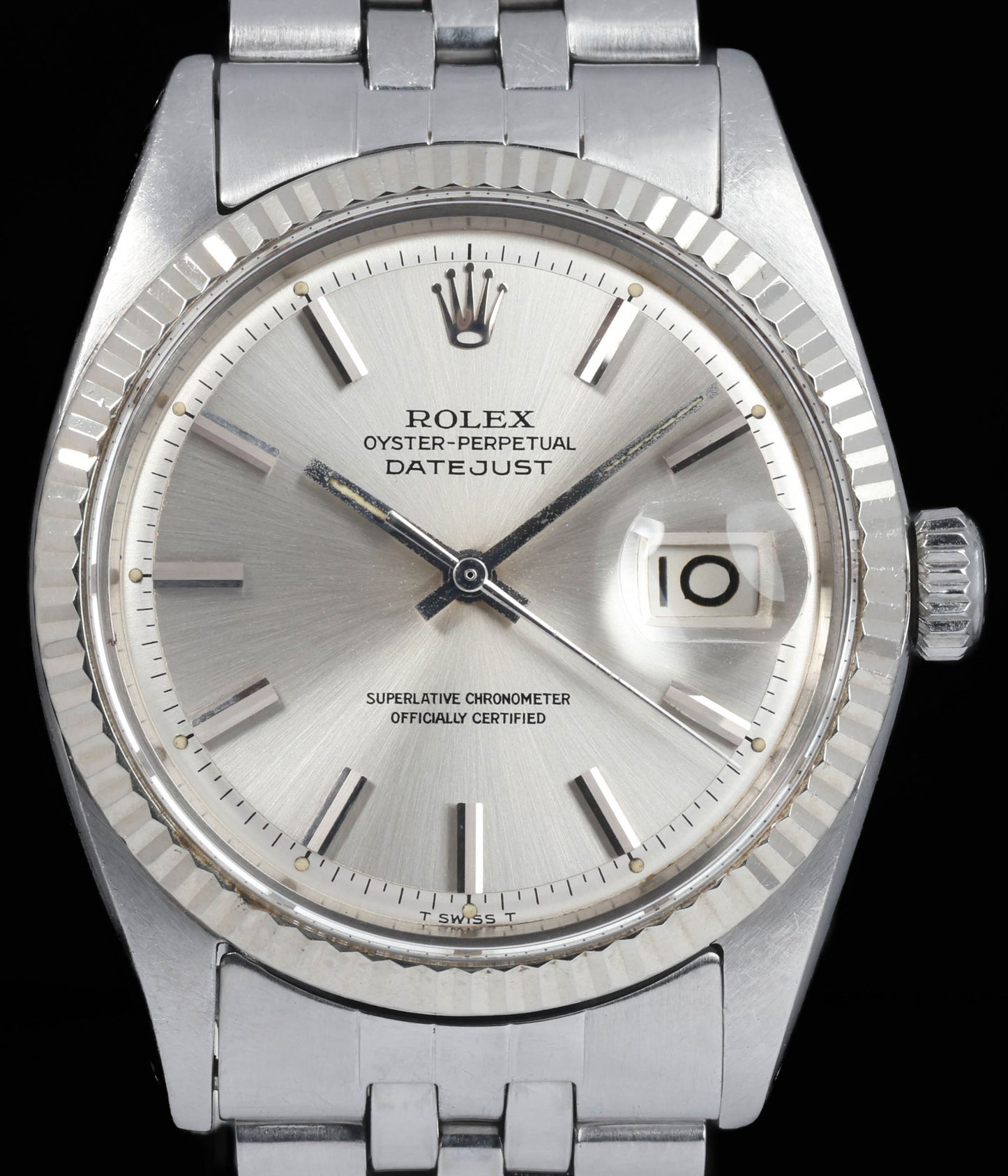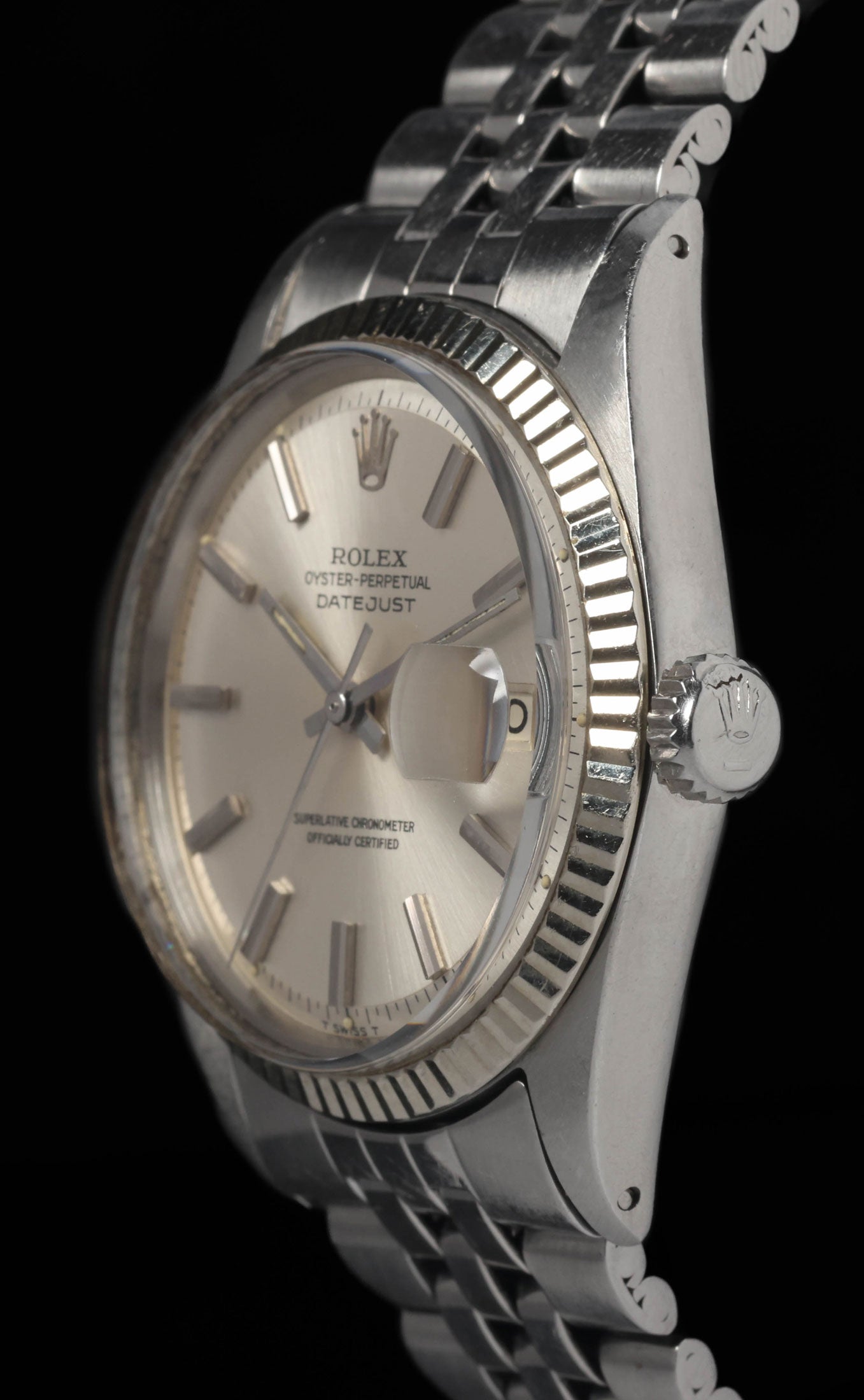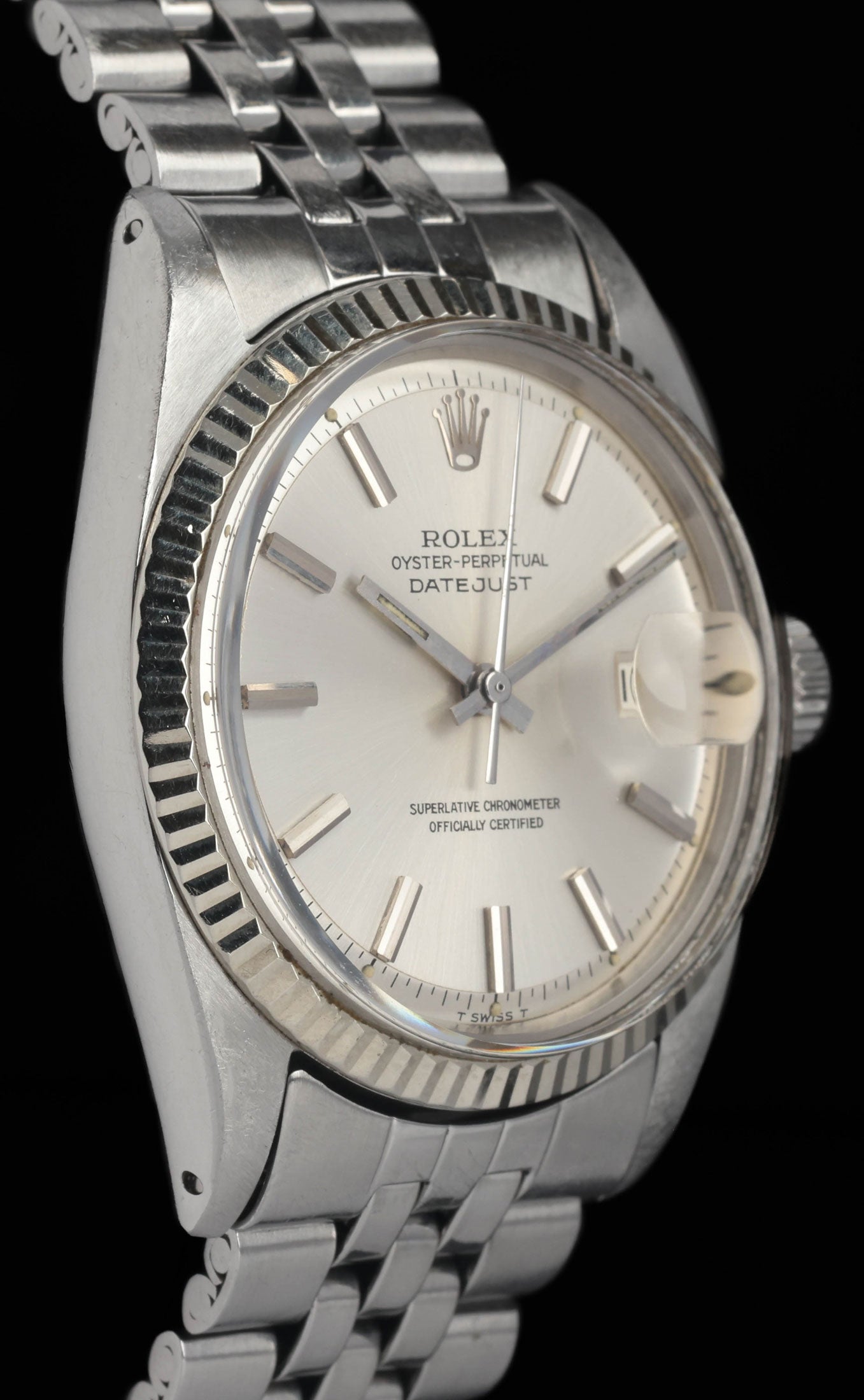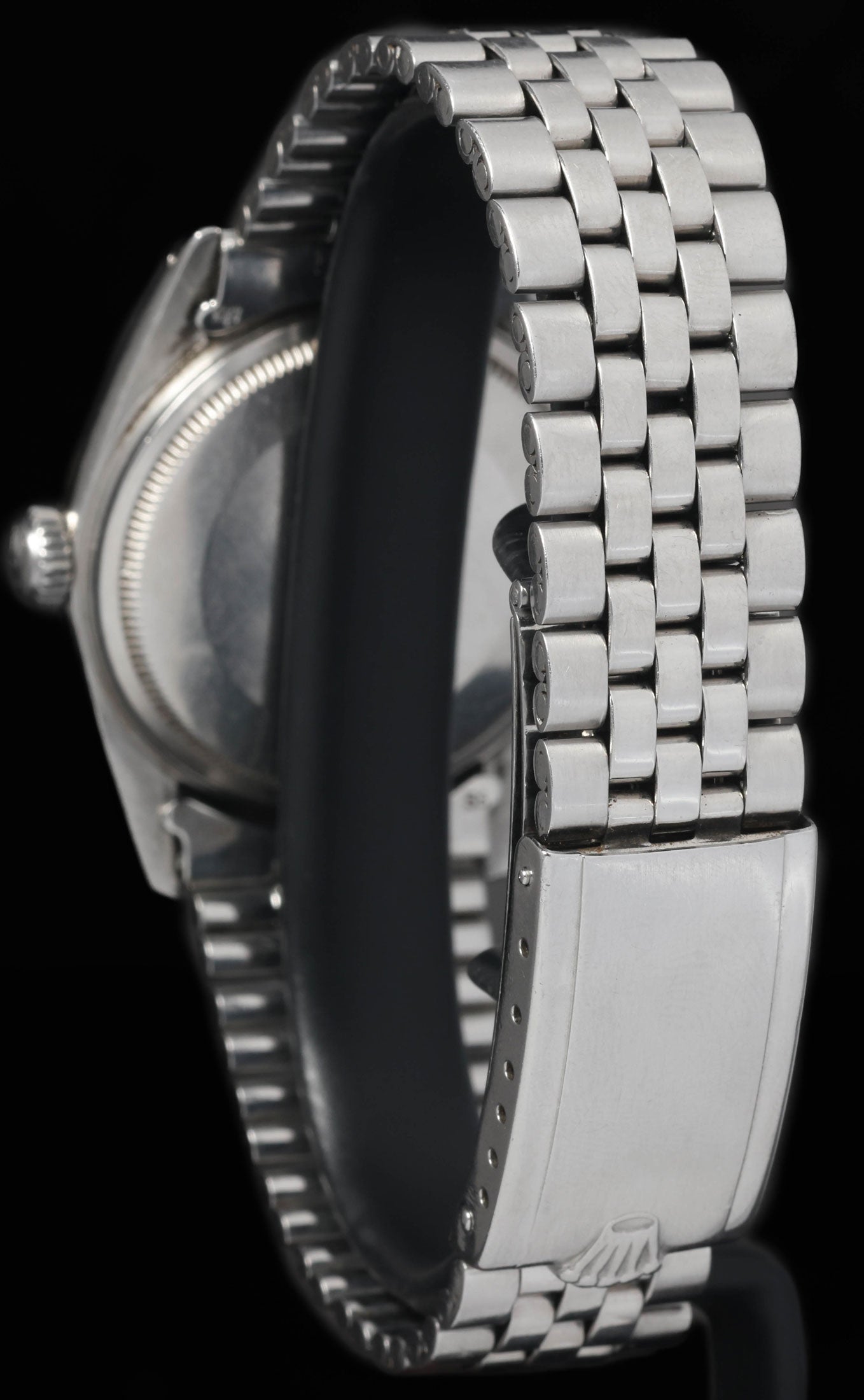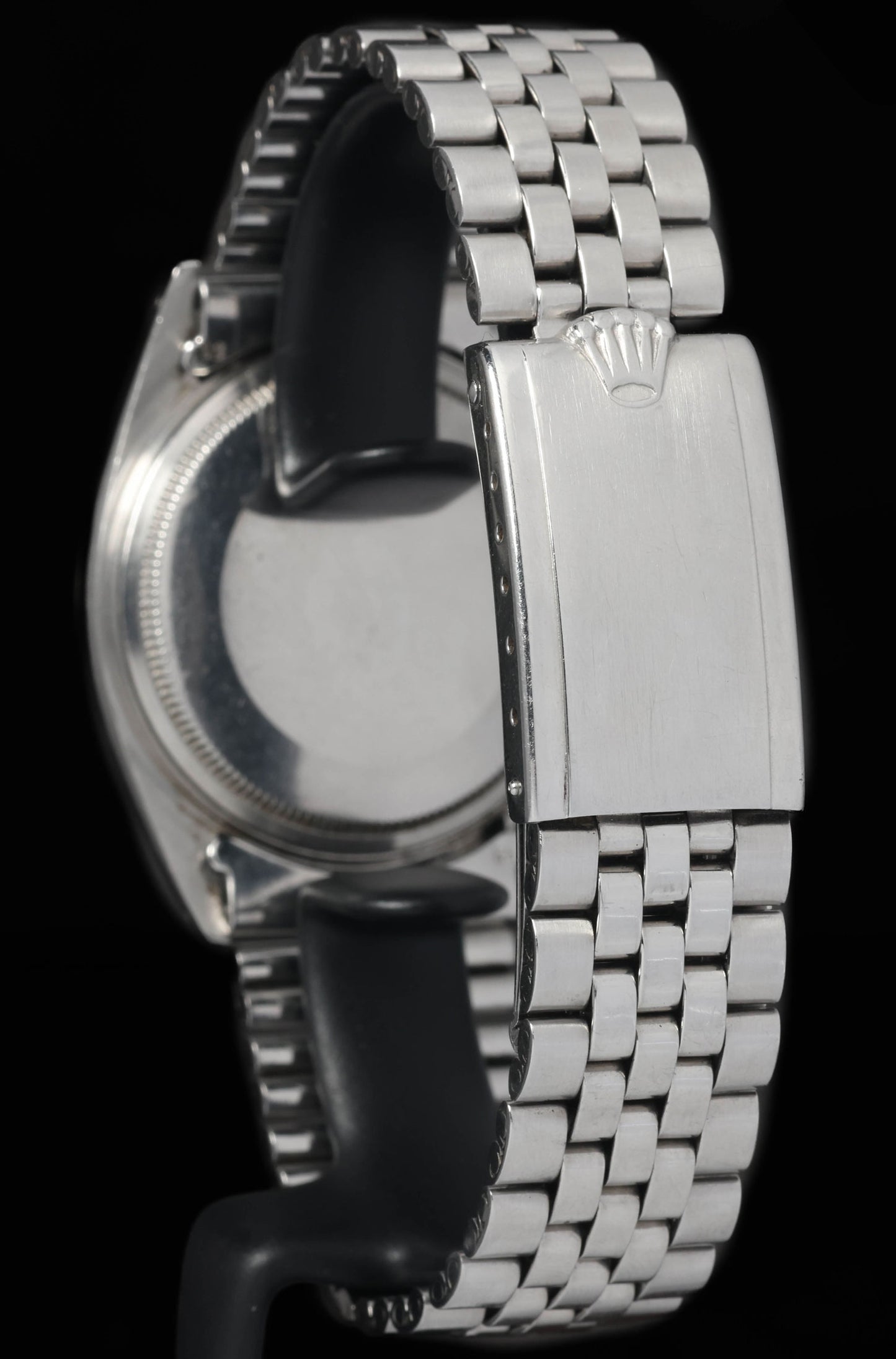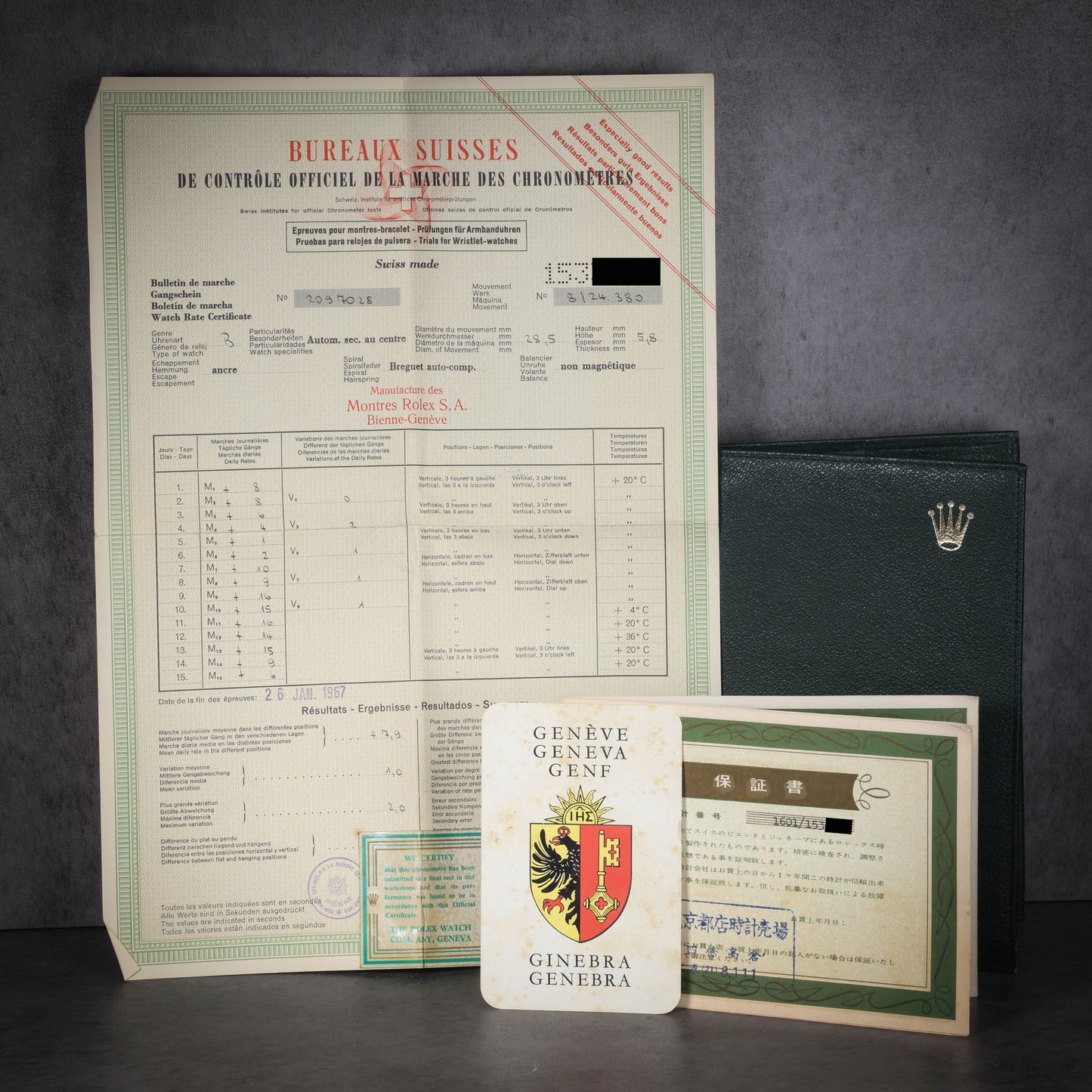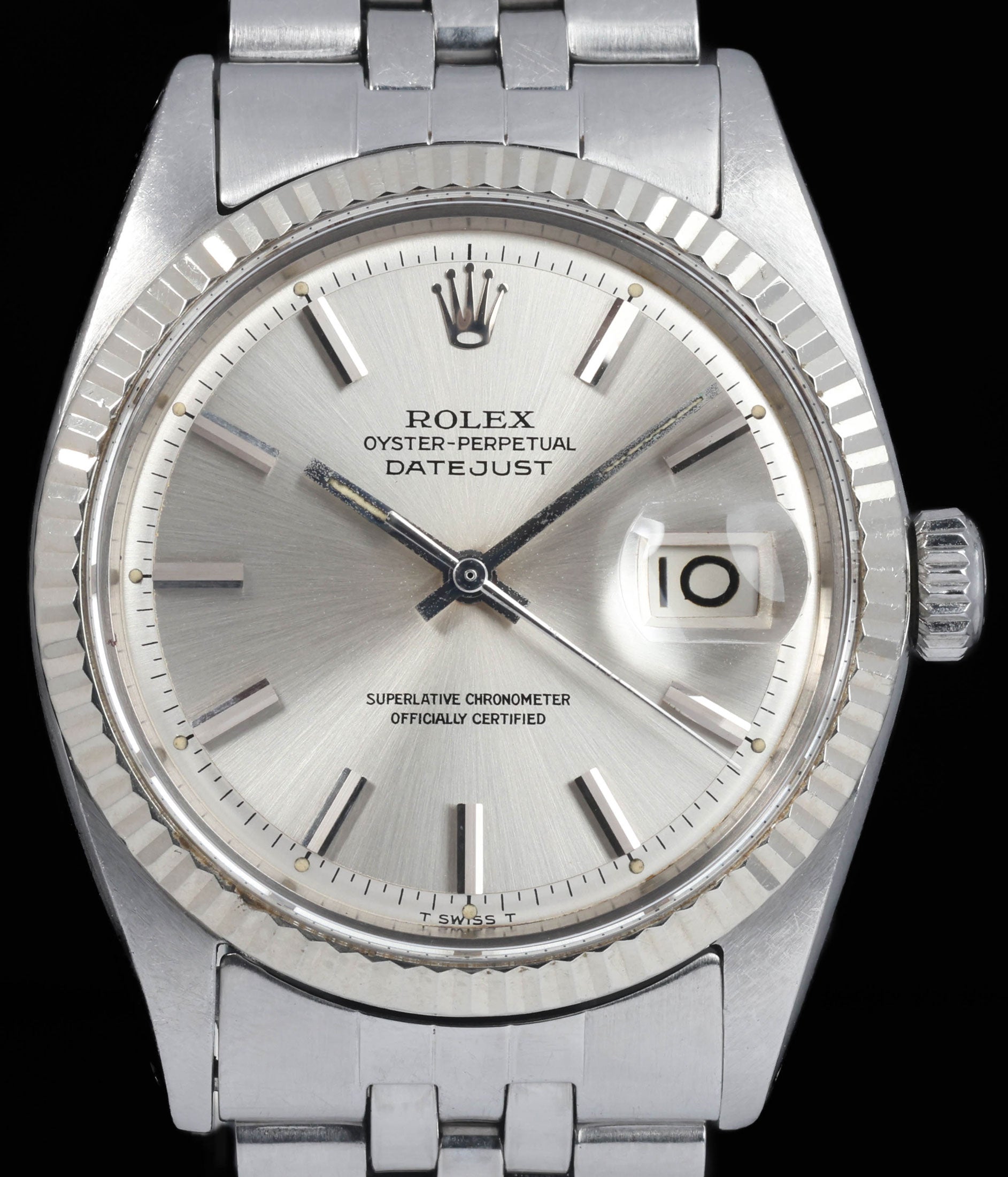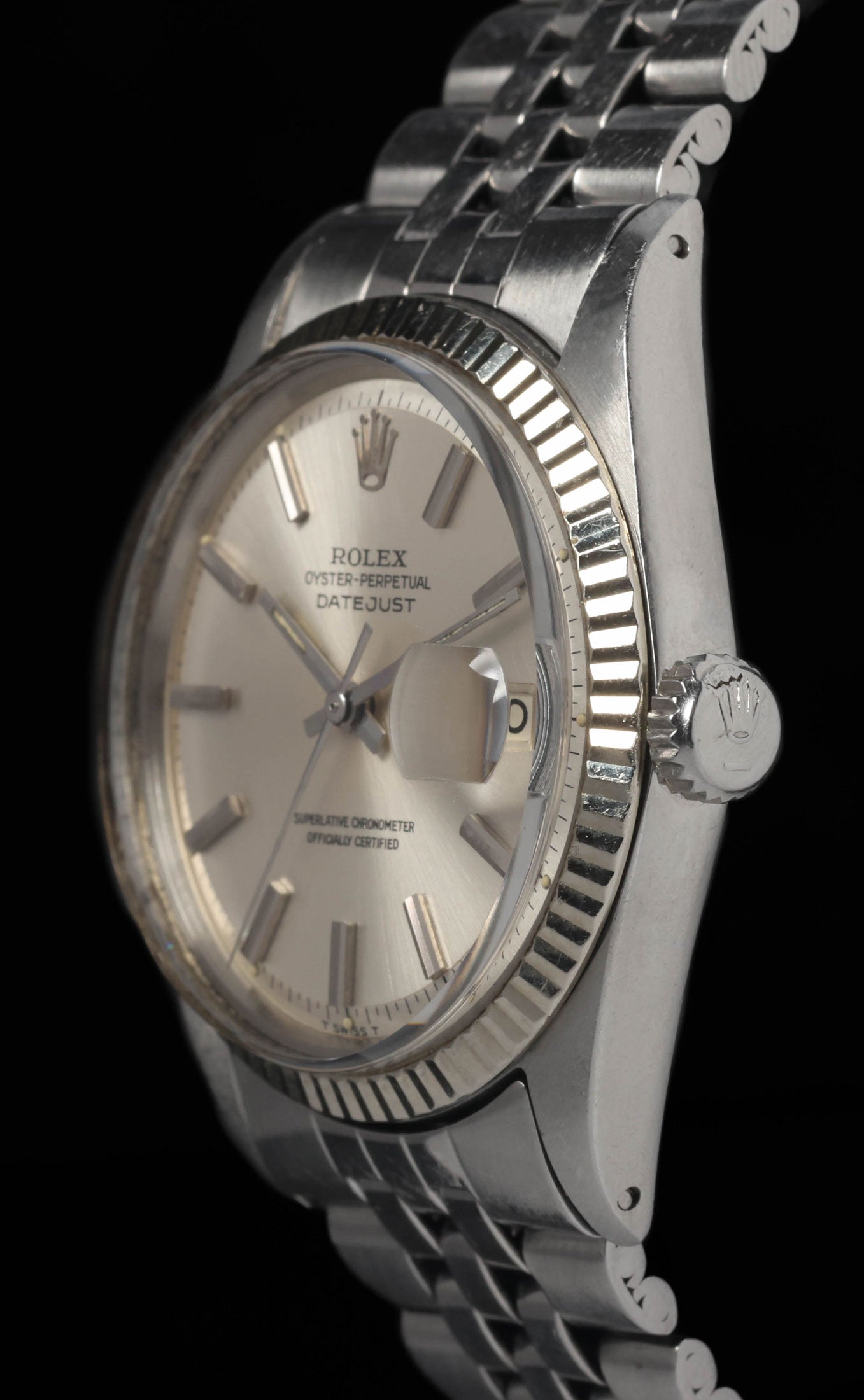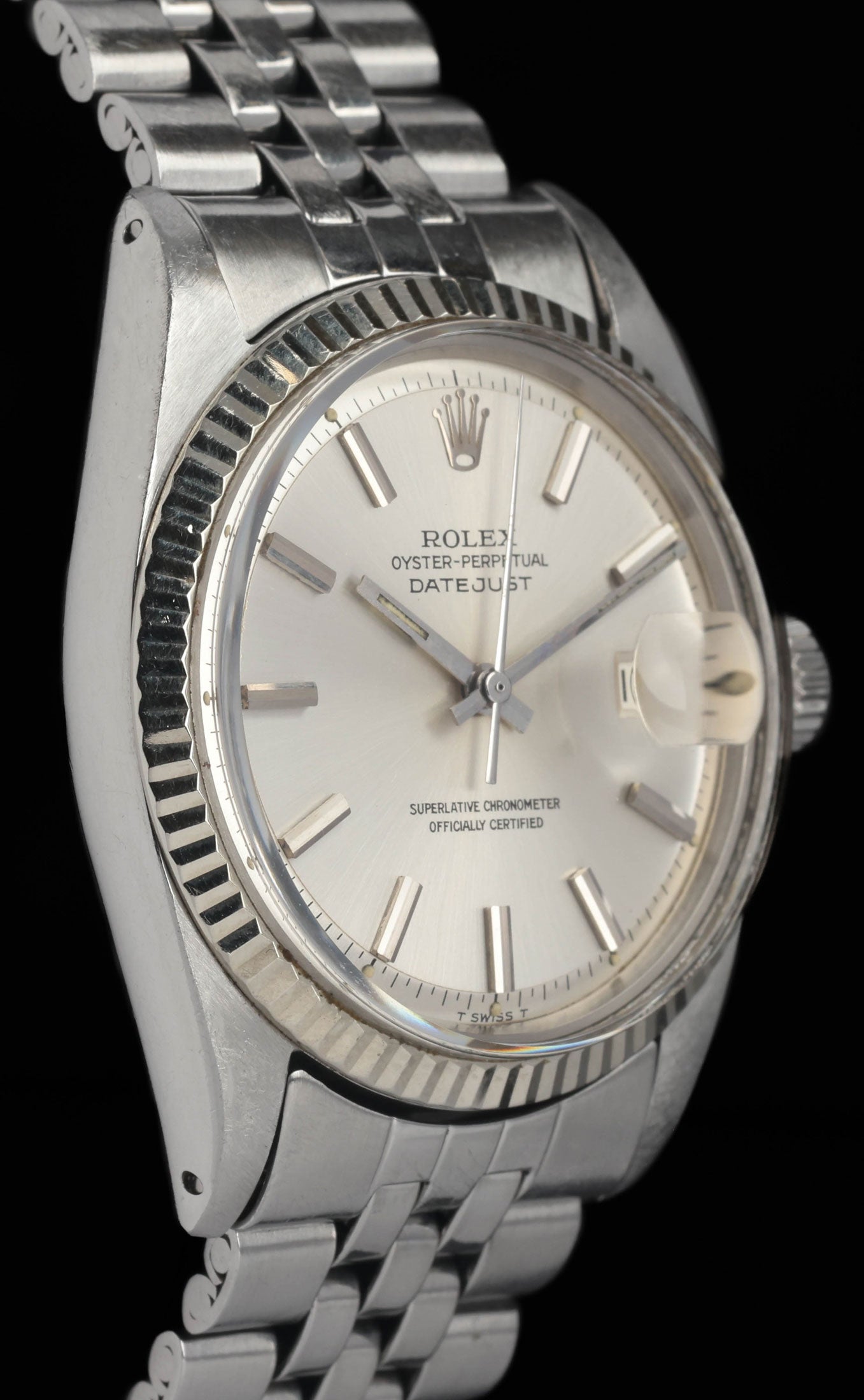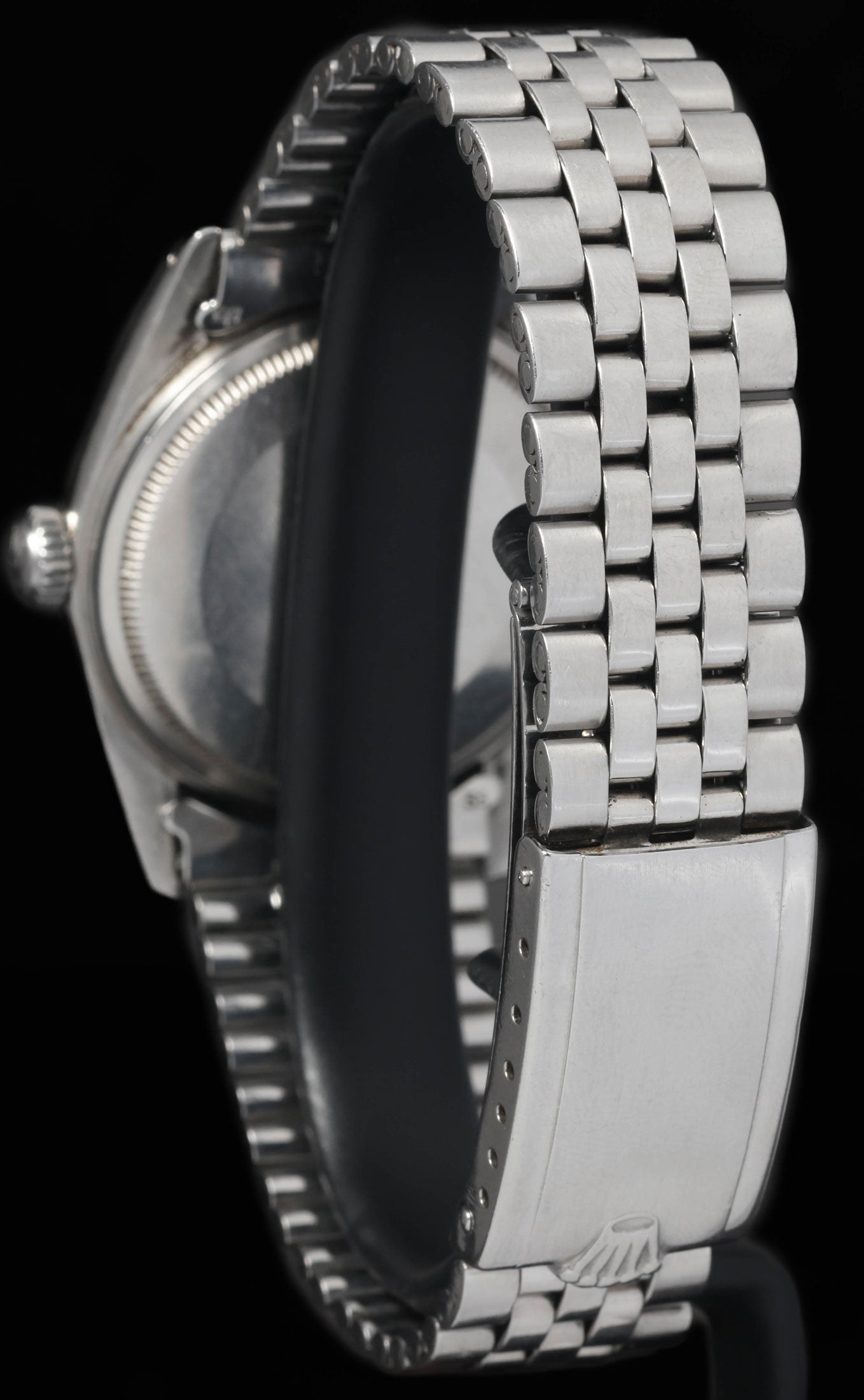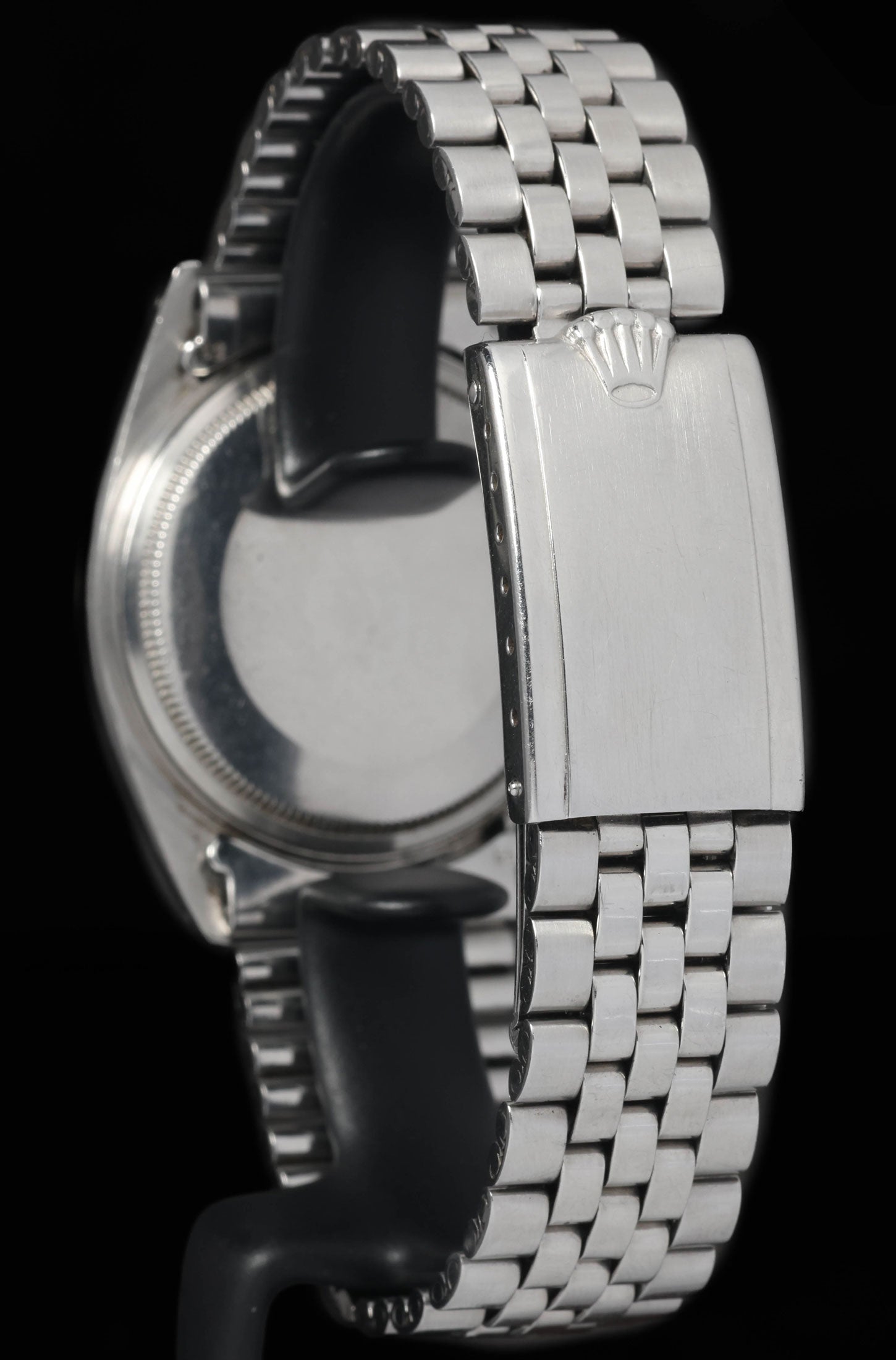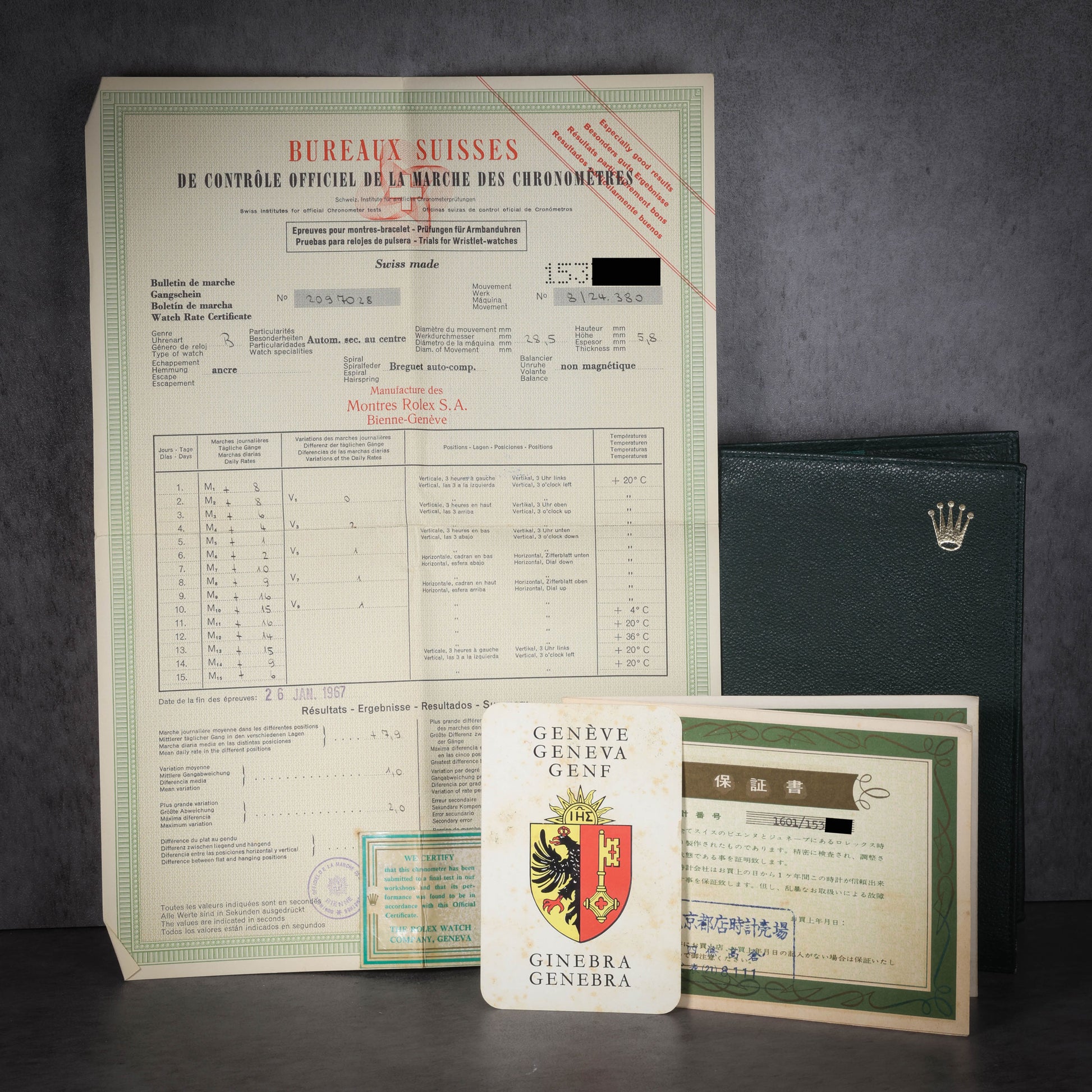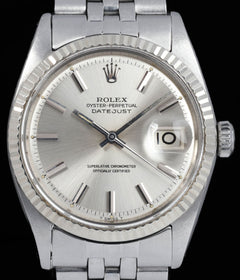Crown Vintage
Rolex Datejust 1601 'Pie-pan' 36mm 1966 Watch and Papers
Rolex Datejust 1601 'Pie-pan' 36mm 1966 Watch and Papers
Couldn't load pickup availability
Rolex Datejust 1601 'Pie-pan' 36mm 1966 Watch and Papers
Case in good vintage condition with light hairlines visible throughout, consistent with age and careful wear. The lugs retain good shape and the fluted bezel shows light wear from regular use. Bracelet in good condition, with surface hairlines visible and moderate stretch present, typical for its age. The dial presents in great condition, clean and well-preserved with all printing crisp and intact. Hands are also in great condition with mild oxidation visible under close inspection, adding to the watch’s vintage character. Overall, this is a well-maintained example that remains honest and attractive, showing natural signs of ageing without compromise to its integrity.
Share
Why we love this watch
Why we love this watch
Rolex Datejust 1601 Pie-Pan Dial
When Rolex introduced the Datejust in 1945, it was the first automatic wristwatch to display the date in a window that changed precisely at midnight. Over the next two decades, it evolved into a true icon. Among its many iterations, the reference 1601 stands out as one of the purest expressions of the model. Its balanced proportions, reliable movement and distinctive pie-pan dial capture the enduring spirit of mid-century Rolex watchmaking.
The 1601 in Context
By the 1960s, Rolex had refined the Datejust into a watch that combined elegance with durability. The reference 1601 encapsulated this approach perfectly. It was designed to serve as an everyday chronometer for the professional class, equally suited to business attire or casual wear. While not positioned as a sports watch, it carried the same Oyster case construction that made Rolex dive and explorer models famous for their toughness.
The Datejust 1601 introduced an aesthetic balance that remains timeless. Its 36 millimetre Oyster case offered ideal proportions for comfort and versatility. The fluted bezel, rendered in white gold on steel models, added texture and light play while marking the Datejust as a more elevated piece than its smooth-bezel siblings such as the reference 1600. With its Jubilee bracelet and domed acrylic crystal, the 1601 became the template for generations of Datejust models that followed.
Case and Design
The 1601’s Oyster case is both functional and refined. Measuring 36 millimetres across and around 12 millimetres thick, it wears with understated presence. The screw-down crown and caseback maintain the water resistance for which the Oyster case is known. Early examples feature drilled lugs, allowing easy bracelet changes, while later pieces sometimes omit this feature. The acrylic crystal softens reflections and lends the watch a warm, vintage character that modern sapphire crystals cannot replicate.
The hallmark fluted bezel is perhaps the most distinctive design element. Made of solid white gold, it reflects light in fine, crisp ridges and defines the Datejust’s visual identity. The interplay between brushed case flanks, polished bezel and curved lugs gives the 1601 a level of finishing that remains impressive even by modern standards.
The Pie-Pan Dial
What separates certain 1601s from later Datejust references is the pie-pan dial. This design feature refers to a gently sloping outer edge that dips away from the main dial surface. The result is a sense of depth and shadow that brings the dial to life. When viewed in different lighting conditions, the slope creates subtle gradients, giving the watch a warmth and dimensionality that flat dials lack.
Pie-pan dials on the 1601 were produced in a variety of finishes including silver sunburst, champagne, black, grey and the distinctive linen texture. Most examples feature applied baton hour markers with small luminous plots at their tips. The hands are simple, polished batons with thin luminous inlays. The printed text follows Rolex’s restrained mid-century typography, with the applied coronet positioned below the 12 o’clock marker and the date aperture at 3 o’clock magnified by the Cyclops lens.
The dials were originally finished with tritium luminous material, marked with the familiar “T Swiss T” or “Swiss T<25” designation at the bottom edge. Over time, many have developed subtle patina, lending each example a unique character. Collectors particularly value dials that remain original and evenly aged, with lume plots that match the hands in tone.
Movement and Technical Details
Powering the reference 1601 is the Rolex calibre 1565 or, in later examples, the upgraded calibre 1575. Both are automatic chronometer-certified movements built on Rolex’s 1500-series architecture, known for reliability and accuracy. The 1565 beats at 18,000 vibrations per hour, while the 1575 increases that rate to 19,800. Each features a free-sprung balance with Microstella regulation, 26 jewels and a bidirectional winding rotor.
The movement drives the date function, which advances instantaneously at midnight. The 1601 does not feature a quickset mechanism, so the date can only be adjusted by cycling the hands through 24-hour intervals. Although less convenient than later models, this operation is smooth and precise, reflecting the robust engineering of Rolex’s mid-century calibres.
Later versions of the 1575 introduced hacking seconds, allowing the wearer to stop the seconds hand when setting the time. This refinement, combined with the proven reliability of the 1500-series movements, ensured the 1601’s reputation for dependable accuracy.
Variations and Dial Combinations
Throughout its production, the 1601 appeared in numerous dial and case combinations. While stainless steel with a white gold bezel is the most recognised configuration, two-tone versions in steel and yellow gold, as well as full yellow gold examples, were also offered. Each variant maintained the same 36 millimetre Oyster case architecture, though the overall personality shifted from understated to overtly luxurious depending on metal and dial tone.
The dial palette was extensive. Silver sunburst dials remain the most traditional, but champagne and grey variants are equally representative of the era. Linen-textured dials introduced tactile variation and remain highly regarded among collectors for their intricate surface patterns. Some 1601s featured darker dials with contrasting applied markers, creating a more modern look that hinted at the evolving tastes of the 1970s.
Lume configurations also varied. Early dials with radium or early tritium often display mellow cream or amber tones today. Later tritium dials aged differently, sometimes developing small, even lume plots that enhance the watch’s vintage appeal.
Bracelet Options
The 1601 was most often delivered on the Jubilee bracelet, a five-link design first introduced with the original Datejust in 1945. Its polished centre links and brushed outers create a balance of comfort and refinement. The bracelet’s suppleness makes it one of the most comfortable designs Rolex has ever produced.
Some 1601s were fitted with Oyster bracelets, giving a slightly sportier feel and emphasizing the watch’s tool-watch roots. Period-correct bracelets can usually be identified by their reference and clasp codes stamped on the inside of the clasp. While stretch in vintage bracelets is common due to decades of use, examples with tight links and minimal wear are prized for preserving the watch’s original feel.
Transitional Characteristics
The 1601 represents a pivotal stage in the Datejust lineage. It bridges the earlier, simpler 1950s references and the modern quickset models that appeared in the late 1970s and 1980s. The pie-pan dial itself symbolises this transition. As Rolex moved toward more streamlined production and modern flat dials, the distinctive sloped form gradually disappeared.
The same evolution occurred inside the case. The 1565 and 1575 movements established the reliability and architecture that Rolex would continue refining for decades. Even without the quickset feature, these calibres demonstrated the precision and endurance that underpin Rolex’s reputation.
Externally, details such as the acrylic crystal, drilled lugs and folded-link bracelets mark the 1601 as a product of its time. Later references replaced many of these with more modern alternatives, but in doing so lost some of the tactile charm that makes the 1601 a favourite among vintage enthusiasts.
Wearing the 1601 Today
On the wrist, the 1601 feels remarkably contemporary despite its vintage origins. Its proportions remain ideal, and the visual contrast of the fluted bezel and pie-pan dial gives it a lively presence. Under direct light, the sloping dial and faceted markers catch reflections dynamically, while the acrylic crystal lends a soft warmth to the entire composition.
Its versatility is another strength. The watch transitions effortlessly from casual settings to formal occasions, embodying the concept of an all-purpose wristwatch that Rolex originally envisioned. Paired with the Jubilee bracelet, it offers understated refinement; on a leather strap, it takes on a quieter, dressier tone.
Many collectors regard the 1601 as the quintessential Datejust because it retains the balance between innovation and tradition that defines Rolex. It has the character of an early Oyster case, the engineering consistency of the 1500-series movements, and the visual grace of mid-century dial design.
The Enduring Appeal of the Pie-Pan Dial
The pie-pan dial remains one of the defining visual features of vintage Rolex. Its depth transforms a simple time-and-date display into something sculptural. This dial architecture also reflects the level of craftsmanship in Rolex’s mid-century production, when dial blanks were carefully stamped and finished to create a three-dimensional appearance.
Collectors often describe the pie-pan dial as giving the 1601 a “living” quality. As light moves across the surface, the edges darken while the centre brightens, producing an effect similar to vintage camera lenses with natural vignetting. It is this shifting interplay of light and form that makes the 1601 a watch to be experienced rather than merely viewed.
Over time, Rolex abandoned the pie-pan construction in favour of flatter dials, which were easier to produce and better suited to sapphire crystals. As a result, the 1601 represents one of the last periods when the Datejust carried this distinctive depth.
Final Thoughts
The Rolex Datejust 1601 with pie-pan dial represents the height of mid-century watch design. It balances precision engineering with refined aesthetics, capturing the essence of what made Rolex the dominant force in postwar Swiss watchmaking. The combination of its 36 millimetre Oyster case, white gold fluted bezel, robust 1500-series movement and distinctive dial geometry has ensured its place as one of the most recognisable watches of the twentieth century.
While the Datejust line has evolved through countless references and technological improvements, the 1601 remains a benchmark. It offers everything essential to Rolex’s identity without excess or modern embellishment. The pie-pan dial, with its interplay of shadow and light, transforms practicality into quiet beauty.
To own a 1601 is to hold a piece of Rolex’s transition from postwar ingenuity to modern precision. It is both a product of its time and a timeless statement of design integrity. Few watches capture such a clear expression of brand DNA, and fewer still have aged with such enduring elegance.
Case & Bracelet
Case & Bracelet
Case in good vintage condition. Hairlines visible around the case. Bracelet in good condition. Light hairlines visible and some stretch as expected with age.
Dial & Hands
Dial & Hands
Dial and hands in great condition. Hands are lightly oxidised.
Warranty & Condition
Warranty & Condition
Crown Vintage Watches provides a minimum 3-month mechanical warranty on pre-owned watches, from the date of purchase.
The warranty covers mechanical defects only.
The warranty does not cover damages such as scratches, finish, crystals, glass, straps (leather, fabric or rubber damage due to wear and tear), damage resulting from wear under conditions exceeding the watch manufacturer’s water resistance limitations, and damage due to physical and or accidental abuse.
Please note, water resistance is neither tested nor guaranteed.
Shipping and insurance costs for warranty returns to us must be covered by the customer. Returns must be shipped via traceable courier. Return shipment must be pre-paid and fully insured. Collect shipping will be refused. In case of loss or damages, the customer is liable.
Our Pledge
At Crown Vintage Watches, we stand by the authenticity of every product we sell. For added peace of mind, customers are welcome to have items independently authenticated at their own expense.
Condition
Due to the nature of vintage timepieces, all watches are sold as is. We will accurately describe the current condition and working order of all watches we sell to the best of our ability.
Shipping & Refund
Shipping & Refund
